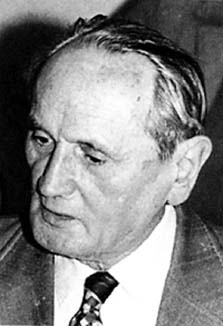


 تاريخ الرياضيات
تاريخ الرياضيات
 الرياضيات في الحضارات المختلفة
الرياضيات في الحضارات المختلفة 
 الرياضيات المتقطعة
الرياضيات المتقطعة
 الجبر
الجبر
 الهندسة
الهندسة 
 المعادلات التفاضلية و التكاملية
المعادلات التفاضلية و التكاملية 
 التحليل
التحليل
 علماء الرياضيات
علماء الرياضيات |
Read More
Date: 14-11-2017
Date: 12-10-2017
Date: 12-10-2017
|
Died: 2 November 1993

Dura Kurepa's parents were Rade and Andelija Kurepa. He was born into a large family, being the youngest of his parents' fourteen children. For the first few years of his life he was living in an area linked to Austro-Hungary, but when he was eleven years old Croatia, Slavonia, and Dalmatia proclaimed themselves an independent state. Shortly after this the newly created Croatia entered into a state union with Serbia, Slovenia, and Montenegro. Kurepa attended elementary school in Majske Poljane, the small town in which he was born, then moved to the nearby town of Glina to continue his education. He completed his high school education in Krizevci before entering the University of Zagreb. Kurepa graduated in 1931 with a degree in pure mathematics and physics, then spent a year teaching as an assistant in mathematics at the University of Zagreb. He went to Paris in 1932 to undertake research at the Faculty of Science and the Collège de France.
In Paris Kurepa was advised by Maurice Fréchet and he submitted his thesis Ensembles ordonnés et ramifiés to the Sorbonne in 1935. The committee set up to examine the dissertation consisted of P Montel as president, M Fréchet as supervisor, and A Denjoy. Kurepa's doctoral dissertation is given in [1]. It is discussed in [7] where Grulovic points out that Kurepa was the first to introduce the notion of a partially well-ordered set in this dissertation (under the name of "tableaux ramifiés"). He also notes that a significant part of Kurepa's results is related to establishing:-
... a connection between the properties of partially well-ordered sets and Cantor's problem, that is, between the properties of partially well-ordered sets and Suslin's problem of the continuum.
After the award of his doctorate Kurepa continued to undertake research, first at the University of Warsaw, then in 1937 back again in Paris. He was appointed as an assistant professor at the University of Zagreb in 1937, being promoted to associate professor in the following year.
The political situation had been difficult between the two world wars with serious differences between those favouring an independent Croatia and the Serbs who favoured centralisation. During World War II Germany and Italy set up a puppet Croatian government in Zagreb in 1941. It collapsed shortly after Germany surrendered in 1945 and Kurepa found himself in the newly formed Yugoslavia. After the end of Word War II, Kurepa went to the United States. There he visited Harvard University, the University of Chicago, the University of California at Berkeley and at Los Angeles, and the Institute for Advanced Study at Princeton. Back in Zagreb, he was made a full professor in 1948. In 1952 he was invited to visit the University of Belgrade. There he [6]:-
... gave talks on the theory of matrices, and held a seminar with topics in set theory, topology and algebra.
Kurepa continued his links with Belgrade through the 1950s, then in 1965 he was invited to fill a chair of mathematics at the University of Belgrade. He accepted the position and remained there until he retired in 1977.
Grulovic, in [7], refers to:-
[Kurepa's] exceptionally full, diverse and rich creative work ...
The topics which Kurepa investigated are very varied but lie mostly within topology, set theory and number theory. He published over 200 papers but this number rises to over 700 items if we include books, articles and reviews. He was fascinated by the continuum hypothesis and the axiom of choice. Perhaps best known is his work on trees and partitions, especially Aronszajn and Suslin trees. His book The Theory of Sets written in Serbo-Croatian and published in 1951 illustrates his interests in that particular area. After introducing the fundamental concepts and elementary operations in Chapter 1, he looks at cardinal numbers in the second chapter, then partially ordered sets and ordinal numbers in the third. Chapter 4 is on topological and metric spaces, with the fifth and final chapter on limiting processes in analysis, measure theory, Borel and Souslin sets.
In number theory he made many contributions, but perhaps his most famous is his open problem on the left factorial function. In 1971 he published his definition of !n, the left factorial function, defined by
!n = 0! + 1! + 2! + 3! + ... + (n - 1)!.
Kurepa conjectured that the greatest common divisor of !n and n! was 2 for all n > 1. There are many equivalent forms of the conjecture, but one of the most natural was given by Kurepa in the same 1971 paper, namely that !n is not divisible by n for any n > 2. If the left factorial conjecture is false we certainly know that it will only fail for some n > 1000000.
Kurepa played a major role in mathematics in Yugoslavia. He was chairman of the Mathematical Institute of the Serbian Academy of Sciences from 1970 to 1980. He founded the Society of Mathematicians and Physicists of Croatia and became its president. He was also president of the Union of Yugoslav Societies of Mathematicians, Physicists and Astronomers, and of the Balkan Mathematical Society.
Books:
Articles:



|
|
|
|
4 أسباب تجعلك تضيف الزنجبيل إلى طعامك.. تعرف عليها
|
|
|
|
|
|
|
أكبر محطة للطاقة الكهرومائية في بريطانيا تستعد للانطلاق
|
|
|
|
|
|
|
أصواتٌ قرآنية واعدة .. أكثر من 80 برعماً يشارك في المحفل القرآني الرمضاني بالصحن الحيدري الشريف
|
|
|